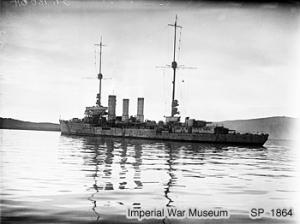 SMS Emden interned at Scapa Flow after World War I
| |
| History | |
|---|---|
| Name | Emden |
| Namesake | SMS Emden |
| Builder | AG Weser, Bremen |
| Laid down | December 1914 |
| Launched | 1 February 1916 |
| Commissioned | 16 December 1916 |
| Fate | Ceded to France, scrapped in 1926 |
| General characteristics | |
| Class and type | Königsberg-class light cruiser |
| Displacement | |
| Length | 151.4 m (496 ft 9 in) |
| Beam | 14.2 m (46 ft 7 in) |
| Draft | 5.96 m (19 ft 7 in) |
| Installed power |
|
| Propulsion |
|
| Speed | 27.5 knots (50.9 km/h; 31.6 mph) |
| Range | 4,850 nmi (8,980 km; 5,580 mi) at 12 kn (22 km/h; 14 mph) |
| Crew |
|
| Armament |
|
| Armor |
|
SMS Emden ("His Majesty's Ship Emden")[a] was a German light cruiser belonging to the Königsberg class, built during the First World War. Emden served in the German Kaiserliche Marine (Imperial Navy) until the end of the war, at which point she was ceded to France. The ship was named after the previous Emden, which had been destroyed at the Battle of Cocos earlier in the war. She mounted an Iron Cross on her stem-head in honor of the earlier Emden. The new cruiser was laid down in 1914 at the AG Weser shipyard in Bremen, launched in February 1916, and commissioned into the High Seas Fleet in December 1916. Armed with eight 15 cm SK L/45 guns, the ship had a top speed of 27.5 kn (50.9 km/h; 31.6 mph).
After her commissioning, she was assigned to serve as a flotilla leader for torpedo boats. She participated in only one major action, Operation Albion, in October 1917. There, she shelled Russian gun batteries and troop positions and engaged Russian destroyers and gunboats. The ship also led a successful, albeit minor, operation against British shipping in the North Sea in December 1917. After the end of the war, she was interned with the rest of the German fleet in Scapa Flow. On 21 June 1919, the interned fleet scuttled itself, though Emden was run aground by British ships before she could sink completely. Ceded to France in the Treaty of Versailles, she was too badly damaged by the attempted scuttling and beaching to see service with the French Navy, so was instead used as a target after 1922, and broken up for scrap in 1926.
Cite error: There are <ref group=lower-alpha> tags or {{efn}} templates on this page, but the references will not show without a {{reflist|group=lower-alpha}} template or {{notelist}} template (see the help page).